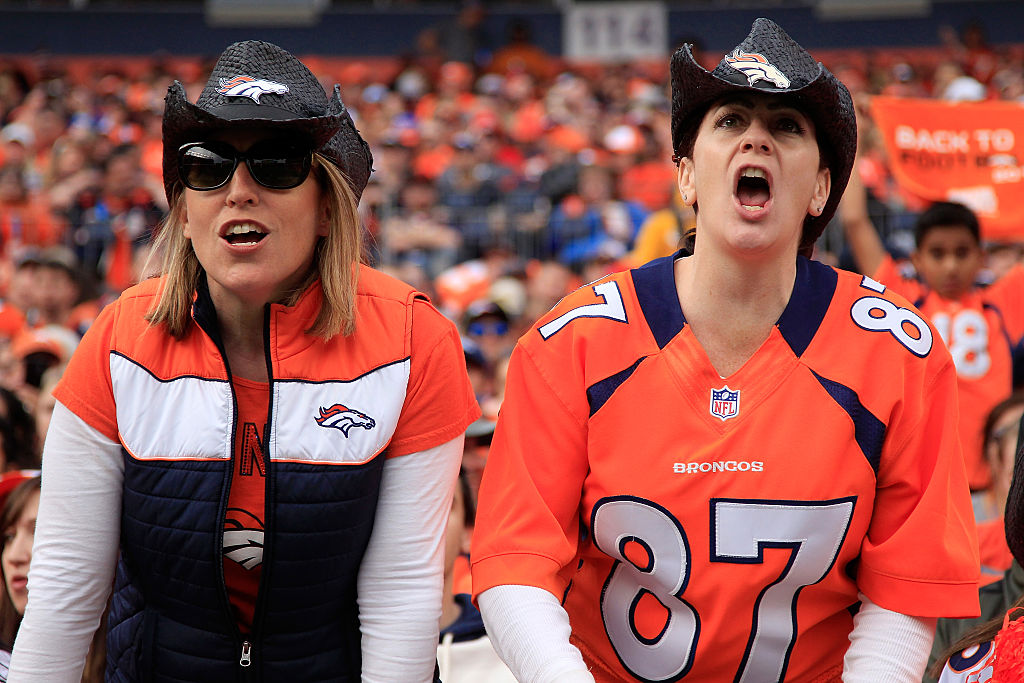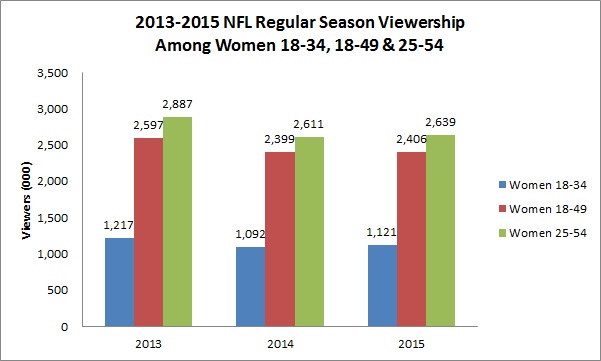For the last fifteen years, the NATIONAL FOOTBA… sorry, the NFL has been the beneficiary of tremendous growth in television viewership, much in large part of the growth of the female fan base. Week after week, you’ve seen reports of how “the NFL is king” to the point that even saying the words “the NFL is king” is a media industry cliché. In a nutshell, football is America’s heroin, an addiction that has been a challenge to kick in spite of all of the off-field drama of the past few seasons.
Yet, in this new era of greater, if not belated, public scrutiny on the league due to scandals involving domestic abuse, players’ health, cause-related marketing and the insipid Deflategate, the assumption that fans would still watch the games had been tested a bit more than reported. Notably, that assumption has been challenged because of how ratings and viewership have shifted among women within the last three regular seasons.
Contrary to widely popular belief, even from well-regarded industry sources, very eager network PR pros and sports talk show radio hosts, the NFL has lost a bit of its Nielsen ratings powers over the last three regular seasons. Based on the all-important advertising selling demos – the highly coveted adults aged 18-34, and the larger catch-all demos of 18-49 and 25-54 – the NFL is still America’s strongest television property. However, that’s based on both genders, especially as men typically dwarf women as televised sports viewers. When distilling ratings and viewership of women only, much has remained unsaid.
The latest
(CBS, FOX, NBC, ESPN & NFL Network). Women 18-34, Women 18-49, Women 25-54.
As the above chart shows, viewership among the three demos dropped significantly between the 2013 and 2014 seasons as the five broadcasters – CBS, FOX, NBC, ESPN and the league-owned NFL Network – collectively declined by 10% each with women aged 18-34 and 25-54, and dropped by 8% with women aged 18-49. In 2015, however, the five carriers found a slight bounce back among women 18-34 with 3% growth. (0% and 1% growth with W18-49 and W25-54, respectively, is considered flat to unchanged in TV industry parlance.)
Even with an uptick in viewership from the 2014 season, to see that the NFL ratings had eroded between 7% and 9% over a two-year period is nothing to scoff at. Within women 25-54, the 9% decline (2.9 million in 2013 versus 2.6 million in 2015) represents approximately 250,000 women tuning out NFL action.
Dive deeper into the viewership tallies and the stories of the female fan base becomes much more interesting when including ethnicity. The data is fascinating in contrast to the racial makeup of the NFL versus the rest of the American populous (depending who you ask, black players make up between 65-70% of the league as whites are about half of those estimates).
(CBS, FOX, NBC, ESPN & NFL Network). Women 18-34, Women 18-49, Women 25-54.
Because they are a smaller demographic in the US, Asian women reflected the largest percentage swings in viewership over the last three seasons. In 2014, the audience among Asian women 18-34 and 25-54 sharply dropped by one-third (30% each) and one-quarter among 18-49 (26%) from the prior year. However, the NFL nearly regained all three Asian age groups in 2015, leading to overall declines between 8% and 13% over three seasons.
(CBS, FOX, NBC, ESPN & NFL Network). Women 18-34, Women 18-49, Women 25-54.
With a much larger footprint in the country, black women also represented a significant shift in the league’s ratings and viewership. In 2014, viewership slipped by 12% among 18-34, and 7% each with black women 18-49 and 25-54. Many black women between 18 and 34 returned in 2015 (a 9% lift), but on a whole, the NFL lost between 5-7% in the age breaks among black women over the observed period. Most interesting in that is how black women 25-54 who left the NFL alone in 2014 didn’t come back at all as the audience was unchanged the following season.
(CBS, FOX, NBC, ESPN & NFL Network). Women 18-34, Women 18-49, Women 25-54.
Among white women, the largest group among all US women, the NFL lost quite a bit of steam. Percentage declines among them from 2013 to 2014 mirrors the same among black women, yet the gains in 2015 are smaller or essentially unchanged. Among all three age breaks, viewership softened by 8% over the three seasons.
(CBS, FOX, NBC, ESPN & NFL Network). Women 18-34, Women 18-49, Women 25-54.
Despite the overall drops among those three ethnic groups, there’s an interesting story with Hispanic/Latina fans as they have actually grown over the last three seasons. While the NFL lost TV viewership among all adults aged 18-34 over the years, Latinas in the age break grew by 11% between 2013 and 2014 as the tumultuous offseason took hold. Being relatively flat the following season, Latinas 18-34 grew by 9% over the analyzed period.
Even more profound was the growth during the 2015 season by the bigger demographics. Latina women aged 18-49 leapt by 15% and the 25-54 demo rose by 21%. Both added approximately 30,000 viewers last season, completely making up for the ratings drop in 2014.
So what does all of this mean for the NFL? Did the 2015 season mean that it has turned the corner when it comes to regaining the trust of women? Certainly not all, and ratings data could never capture the sentiments of anyone overwhelmed by the deluge of stories from Football Gone Bad over the last few years, especially many of the women reading this. More over on a macro level, the loss of female viewers is a loss of eyeballs not only for networks, but advertisers – national and local – looking to grab their attention as they are major purchasing influencers in households across the country.
However, the league could perhaps point to the growth of the Hispanic/Latina fan base as a proving point of its resilience and undeniable, if not overwhelming, marketing machine. In addition, while the league had noticeable ratings erosion among all young adults over the years, last season proved that it may take more than cord-cutting (by legal and illegal means) to break the NFL’s hold on traditional/lineal television.
At the start of the 2014 season, there had been passing inquiries about how much the domestic violence, child abuse and to a lesser extent, head trauma issues affected television viewership. With some snapshots from the first few weeks of that campaign, a few outlets such as FiveThirtyEight declared that little had changed. However, while those reports weren’t wrong on the surface, the NFL’s problems persisted past September along with the growing conundrum of uncompetitive games during the primetime windows that turned off viewers of all demographics.
Aided by the slight recovery of lost female viewers in 2015, it is impossible to deny that the NFL is still the most popular entertainment company in the United States, despite continually shooting itself in the foot with the public. However, with the league’s inconsistent disciplinary measures and even the national anthem controversy revolving around Colin Kaepernick, the 2016 season will be another test for the NFL to see if it can fully regain the trust of the female viewers they arguably took for granted for the past fifteen years.

